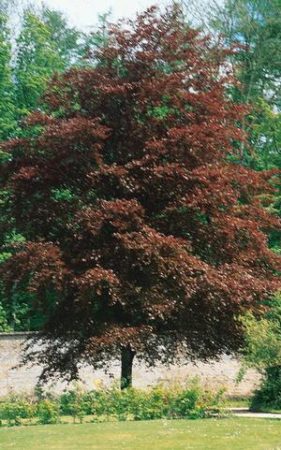Post category: Trees
By choosing plants that need least care, the amount of effort in garden maintenance can be greatly reduced. Trees are the easiest group of plants to look after – the bigger the area of trees that fill the garden, the less work involved. Trees intercept light before it reaches the ground, and their deep root system gives them access to supplies of soil moisture and nutrients that smaller plants cannot reach. We can use the success of trees to our own advantage.

Trees
Because trees grow large, they can be used to fill space. Trees can look after themselves. Once they get above the grassy layer, they are away. As time passes, their competitive advantage becomes so great that grass and weeds find it difficult to grow. The ground layer beneath trees becomes dominated by plants which tolerate shade.
Planting
Trees are best planted as young plants two or three years old. The smaller plants establish more successfully and produce better anchor roots for the future. But they are also easier to plant than larger sizes; they do not need staking, and they are cheaper.
In the establishment of large areas of trees, using small plants, a number of short-cuts can be used. Although it is desirable to dig, plough or rotavate the area to be planted, it is not essential. The existing grass and weeds can be controlled by two applications of Round-up or similar glyphosate-based product.

Trees
Planting should be carried out in late autumn and early spring. The dead sod can be simply cut in an L-shape with a spade, and the sod lifted. The young tree is slotted into the hole and the sod firmed back in place. Using this method, it is possible to plant several hundred trees in a single day.
Weed control must be kept up for the first few years. After that, the trees themselves will be able to keep control. Only elder, briars and large perennial weeds will need control. Feeding the young trees in the early years will result in quicker establishment and bring forward the day when weed control can be abandoned.
Thinning
In a natural situation, a surplus of young trees attempts to colonise a free piece of ground. In time, some will dominate the rest, and there will be losses. Similarly, in establishing garden woodland planting, it is desirable to slightly over-plant to start with. Planting at a random spacing averaging two metres apart will ensure a quicker cover of the soil surface, and will provide for early losses.

Trees
After eight or ten years, it will be necessary to reduce the number of trees by about half, choosing the poorer specimens to go. These can be cut down and removed. Further thinning, again by about half the number of trees, can be carried out twenty or twenty-five years after planting.
Garden woodland can be established to cover very small areas – as little as a few hundred square metres. Small trees like birch, alder, hazel and holly could be used in smaller gardens. Where there is plenty of space to fill, the large forest trees like oak, ash, beech, elm, lime, pine, horse chestnut, spruce and sweet chestnut are ideal.
Established woodland has an extremely low maintenance demand, needing only the occasional control of woody weeds and ivy. The life of such a garden feature will range from one hundred years for birch to several hundred years for oak and Spanish chestnut.


